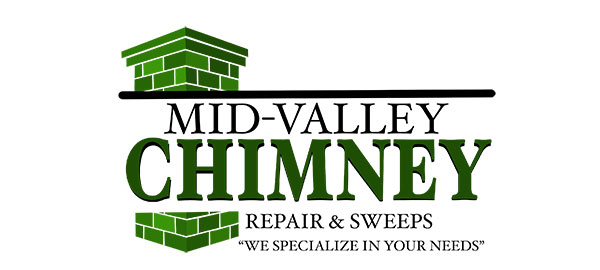Safeguard Your Bricks & Mortar by Hiring Us for Professional Waterproofing Services
Chimneys are constantly exposed to the elements. Since they can’t be relocated indoors, they take a beating from severe weather all year round, with water and moisture being the most common cause of chimney deterioration and damage.
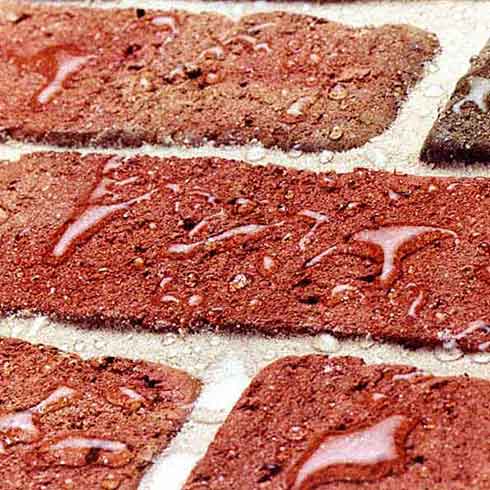
Water Beading on Bricks
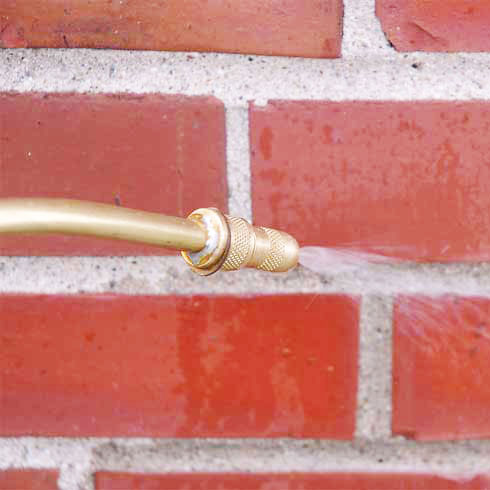
Water Repellent Spray on Bricks
Call 513-727-0994 or reach out online for details.
Why Invest in Professional Waterproofing?
Why do we encourage our customers throughout Cincinnati, Loveland, Mason, West Chester, Montgomery, and more to invest in professional waterproofing services with us?
- It stops the freeze/thaw process. The freeze/thaw process is extremely harmful, and it’s something we can’t exactly avoid here in Montgomery County. Waterproofing keeps water from entering, so it can’t freeze, expand, and trigger more damage.
- It prevents cracking and spalling. A chimney that’s not protected from water will simply continue soaking in moisture, which leads to cracking, crumbling, and missing bricks. This is both unsightly and causes even more damage to occur throughout your system over time.
- It allows your brickwork to still breathe. Bricks are more finicky than we give them credit for. While they need to have that protective layer that keeps out water, they also need the ability to breathe out any vapors and pre-absorbed moisture. This need for vapor permeability is why trusting professionals is so important, as most store-bought sealers don’t allow for this.
- It keeps your brickwork looking great. There’s no denying that masonry chimneys offer a timeless look to your home. People have been investing in masonry walls, chimneys, archways, and more for decades because it’s reliable and it never goes out of style. But it needs to be maintained to uphold that great aesthetic. Otherwise, you’ll face discoloration, decay, and more.
- It keeps you safer. In the end, using a fireplace and chimney that’s damaged puts your entire household at risk, and leaves you more likely to experience chimney fires, house fires, carbon monoxide leaks, smoke in your space, and other issues. Invest in waterproofing, so that your system stands strong and keeps you protected for the long haul.
- It saves you money. Everything we’ve already discussed costs you money. When you consider the cost of addressing water-related damages, investing in repairs after a house fire, paying medical bills after someone was hurt or ill, or making plans for an entire rebuild, waterproofing is always going to be the more cost-effective option.
How Do I Stop My Chimney From Leaking?
So yes – waterproofing is crucial in shielding masonry from absorbing water and preventing long-term issues like spalling and general decay. All that said, though, protecting your chimney against water is a multi-step process. Your chimney system has built-in features that can keep water out of your chimney, and they work together with waterproofing to keep your chimney and fireplace as water-tight as possible.
Which parts of your chimney are most important in the fight against water?
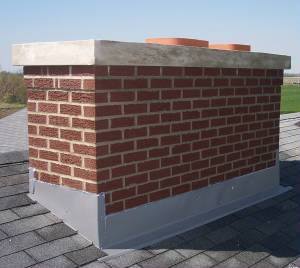
- Crown: The crown is a concrete slab at the top of your chimney. A proper chimney crown should overhang the chimney so that it redirects rain and water away from the structure and into your gutters. Crowns can get damaged over time, but cracks can be found easily during a chimney inspection.
- Cap: Chimney caps protect from weather and animals. They sit at the very top of your chimney and are typically made of copper or stainless steel – both materials are highly resistant to corrosion. The top of the cap is solid, while the sides are perforated, which allows exhaust and other products of combustion to exit your home safely. Over time, chimney caps can be damaged by wear and tear or bad weather, in which case a replacement may be in order.
- Flashing: Chimney flashing is a metal weather stripping that goes around the area where your chimney meets your roof. It acts as a sealant that directs water away from areas of your roof where water pooling is a problem and home leakages are more likely to occur. Aluminum, galvanized steel, copper, and PVC vinyl are the most used materials for chimney flashing.
- Chase Cover: The chase cover acts as a metal crown that’s typically used on prefabricated systems, but can be used in masonry setups as well. Like the crown, it sits at a slope, so water is directed out and away from the sides of your chimney chase.
If any of these components are missing or show signs of wear, call us in. The sooner we can tackle repair work, the better off your system – and your budget – will be.
What Are the Signs of a Leaky Chimney?
Water damage can go undetected for a very long time, so, chances are, the damage is already extensive once you start to see evidence. Keeping up with annual chimney inspections as recommended by the Chimney Safety Institute of America (CSIA) can help identify vulnerable points in your chimney system before they become a budget-breaking problem. Keep an open eye – or sometimes an open nose – for the following:
- Odd or Musty Odors Coming From the Chimney: If you’re a longtime homeowner, you’re no stranger to the weird chimney aroma. Sometimes a family of critters has built a home which can cause unpleasant odors, while other times leaves and branches may have become lodged in your chimney and started to rot. One of the most common sources of fireplace and chimney odors is moisture. Water can find its way in from multiple areas and once it settles, it can develop a musty odor.
- Mold and Mildew Growth: Remember that musty odor mentioned above? If it has persisted for a long time or is getting stronger, it may be a sign that mold or mildew has started to grow somewhere in your chimney system. Mold can grow quickly and become a serious health hazard if not treated properly and promptly. Side effects of mold exposure include runny nose, sneezing, sore throat, dizziness, and headaches. These can worsen if a member of your household suffers from asthma or another upper respiratory illness.
- Water Stains on the Walls, Ceilings, or Chimney: The most visible sign of water damage is staining. If you begin to see water stains on the walls and ceiling near your chimney, it could be due to a chimney leak. When your flashing or chimney crown is damaged, water may begin to pool in areas on your roof. This water then spreads inside your ceiling and down the walls, leading to chimney stains. Sometimes, staining on the exterior chimney appears as a white, chalky substance called efflorescence.
- Spalling or Damaged Masonry: Bricks are water absorbent and can erode over time due to water damage. After years of weather exposure and undergoing the freeze/thaw cycle, bricks may start to crack and chip. Spalling is when bricks are so damaged they begin to fall apart. If you see any spalling or cracking in the masonry of your chimney, it is likely due to a leak.
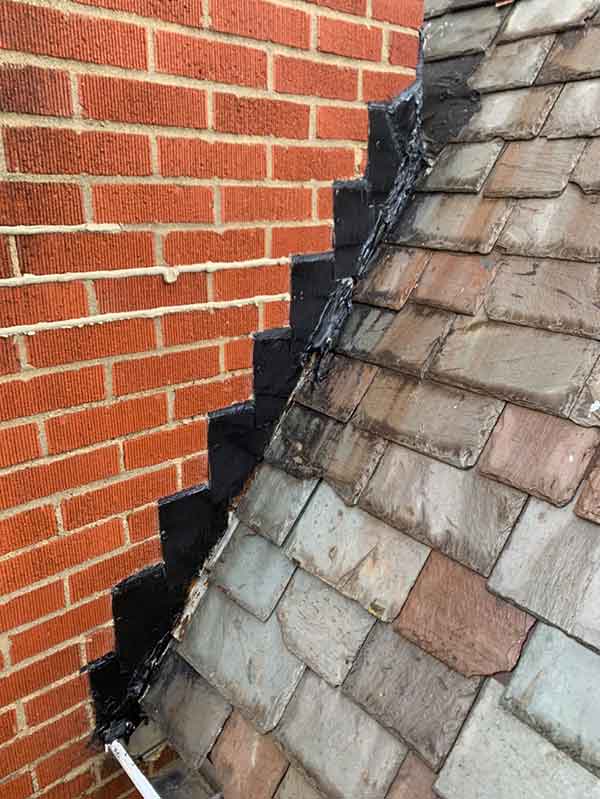
Step Flashing
What To Do if You Already Have Damage
Is it clear that you already have damage? Have you spotted discoloration, cracking, decay, crumbling mortar, or other issues? Or maybe your system just simply isn’t running as efficiently as it used to? In these cases, you won’t want to invest in waterproofing services until after any necessary repairs can be completed.
The first step to getting these tackled? Schedule your inspection. Sometimes damages are obvious and apparent, but many times they’re hidden away. This means you could be experiencing risks when operating your fireplace and not even know it.
Get your inspection booked so that you know your system is in good condition before diving into any preventive maintenance.
Can I Try Chimney Waterproofing Myself?
We would strongly advise against DIY waterproofing. Yes, there are products sold in stores that claim to offer adequate protection – and chances are they will keep water out! …for a while.
The problem with most of these is that they aren’t vapor-permeable, so they’ll simply trap in any moisture that’s already soaked into your brickwork. This means damage will only continue to occur, and you’ll still need masonry repairs down the line.
Along with this, an inexperienced hand could easily miss important areas of the system, meaning your chimney will still be just as vulnerable as it was before the products were applied. Our certified techs will ensure the process is done correctly from start to finish, so you can rest easier knowing your masonry is protected for years to come.
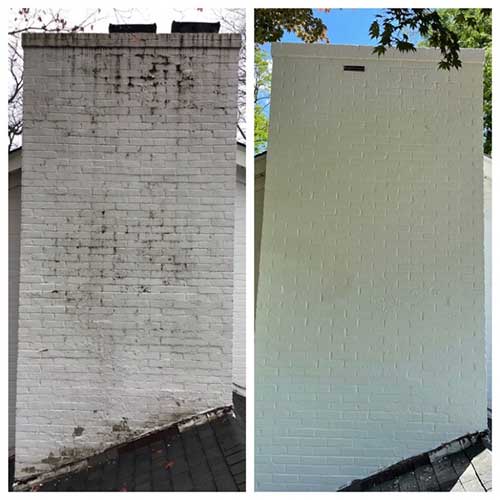
Are Chimney Leaks Covered by Homeowner’s Insurance?
Whether or not your homeowner’s insurance policy will cover the cost of repairing a chimney leak depends on a few different factors. Some policies will cover leaks depending on the cause of the leak – usually only under unforeseen or sudden problems, like heavy winds, a flood, after a lightning strike, etc. So yes – if your chimney cap was cracked or your masonry was damaged during a storm, your insurance will likely cover the repair work.
That said, if the damage was caused due to neglect on the part of the homeowner (like not scheduling repairs or getting that annual inspection booked), then it’s more likely that you will not get the coverage you’re hoping for.
It’s important to read your coverage carefully before filing a claim since many policies will not cover the costs of ongoing issues if the insurance company determines it was preventable. Reporting a leak as early as possible can help you get your claim processed faster and make it more likely for you to get some type of payout, so be proactive throughout the process.
Don’t Wait, Protect Your Chimney Now
The best way to save on expensive repair work needed to fix chimney leaks is by being proactive with a prevention plan. Waterproofing is one of the quickest and easiest ways to give your chimney baseline protection against water and the costly damage it can cause.
If you’re ready to schedule an appointment for waterproofing, reach out to Mid-Valley Chimney today. Our customer service team is standing by and ready to get started. You can reach one of our representatives by phone at 513-727-0994 or request an estimate online. Thanks for trusting us!
If you need a leaky chimney repair, one of the solutions could be a crown repair or rebuild. We can tell you which way to go.
